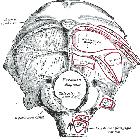Basilar fractures of the skull
Basilar fractures of the skull, also known as base of skull fractures, are a common form of skull fracture, particularly in the setting of severe traumatic head injury, and involve the base of the skull. They may occur in isolation or often in continuity with skull vault (calvarial) fractures or facial fractures.
Epidemiology
The majority of basilar fractures occur as a result of motor vehicle accidents, with sports injuries, falls and assault being other frequently encountered antecedents . Clearly, the relative incidence and demographics affected will vary widely depending on regional differences and mechanism.
Clinical presentation
Skull base fractures are often encountered in the setting of severe head injury and thus the damage to the underlying brain and/or intracranial hemorrhage dominate the clinical presentation.
It is also rare to not obtain a CT of the brain in all such cases, however, historically a number of signs were described as being helpful in suggesting the presence of a base of skull fracture:
- anterior cranial fossa fracture
- petrous temporal bone fracture
Pathology
Fractures may either occur at the site of direct impact or remotely due to forces passing through the skull . As a general rule most base of skull fractures result from impact to the skull around its base (e.g. occiput, temporal region, frontal region – the so-called "hat band" distribution. Less commonly, base of skull fractures are extensions of fractures that have occurred due to impact at the vertex .
The specific pattern of fracture and the associated complications (e.g. CSF leak, sensorineural hearing loss, cranial nerve palsies etc...) will depend on the location of the fracture. Generally, the direction of a fracture will be in line with the direction of impact (i.e. a transverse fracture will result from an impact on the side of the head) .
As is the case elsewhere, fractures may be linear, comminuted, depressed or compound.
Radiographic features
CT is the investigation of choice and is able to identify most fractures. CT features are discussed in the skull fracture article.
Specific types of base of skull fractures include:
Siehe auch:
und weiter:

 Assoziationen und Differentialdiagnosen zu Schädelbasisfrakturen:
Assoziationen und Differentialdiagnosen zu Schädelbasisfrakturen:

